- Apply
- Visit
- Request Info
- Give
Psychology Researchers Publish on Human, Pigeon Suboptimal Choice
Written by Vania Galicia
Published on September 06, 2019

Eastern Connecticut State University Psychology Professor James Diller and recent graduate Malvina Pietrzykowski ’19 were published in Springer’s “Learning and Behavior Journal” on Aug. 19 for their research titled “Human and Pigeon Suboptimal Choice.” The research looked at the completion of similar tasks by humans and pigeons to determine whether non-human performance can serve as a model for human gambling research.

The project was designed by Diller’s undergraduate mentor, Maggie McDevitt of McDaniel College, who ran the pigeon component of the experiment. Pietrzykowski, a former student of Diller’s, ran the human subject experiment. Students from McDaniel College’s psychology department also assisted with data collection.
To determine whether pigeons could serve as a model to observe the way humans behave when gambling, the researchers carried out two sets of experiments that evaluated both human and pigeon behavior. The task for pigeon subjects involved each pigeon choosing between two different color-lit keys by pecking at them. Each key allowed the pigeons to access food for a certain amount of time depending on the color—blue for 10 seconds; red for 0. Two other colors consistently allowed the pigeons to access food for three seconds.
The task assigned to the human subjects consisted of humans playing a computer game that awarded points depending on the color they chose. Like the pigeon experiment, each color had a set point value and subjects had to choose a color to earn points.
The results of the experiments showed that the pigeon subjects chose to “gamble,” or test their luck, more often than humans and that humans did share some patterns with pigeons when it came to “gambling.” However, although the results of the experiments suggest that humans and pigeons can behave similarly when assigned tasks that include a suboptimal choice, Diller concluded that more research must be done to truly determine whether pigeons are good subjects to test in comparison to human gambling behavior.
Diller commented on the experience, “It has been a lot of fun working across ‘academic generations’ on this project. I think this type of thing underscores the value of research experience and mentorship for students.” Speaking to his mentor and research colleague, he added, “If it weren’t for Maggie, I know I wouldn’t be at Eastern, and I’m proud to pass that type of experience on to Malvina and my other students.”


